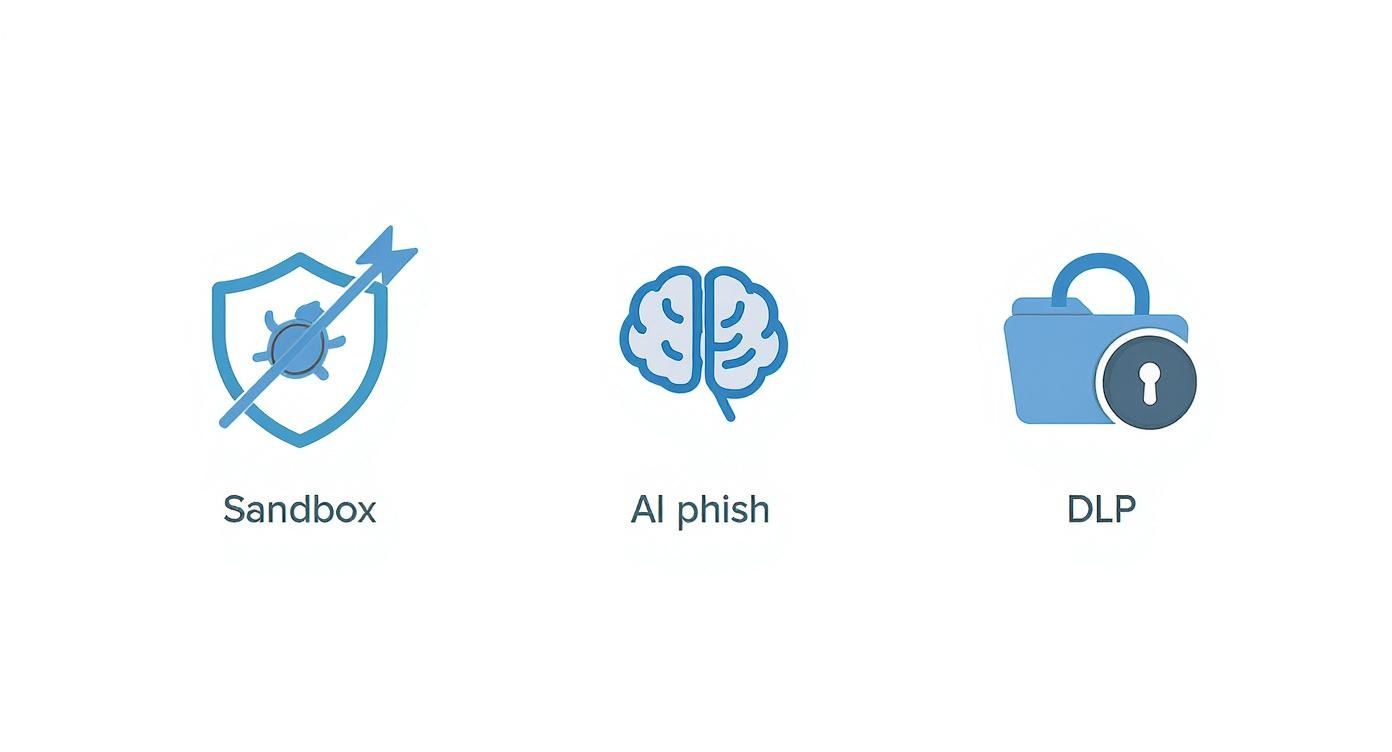The best email security solutions act like a specialized team of bodyguards for your inbox, employing a multi-layered defense to stop sophisticated attacks before they can cause chaos. It's about using tools like AI-powered threat detection, attachment sandboxing, and data loss prevention to stay ahead. Top-tier platforms like Proofpoint Essentials, Mimecast, and Barracuda Essentials go leagues beyond the basic filters that come with your standard email suite, delivering the kind of robust protection modern businesses simply can't do without.
Why Your Business Needs Better Email Security
Email is the lifeblood of just about every business out there, which also makes it the number one way for cybercriminals to get in. We've moved far beyond simple spam. Today's threats are cunning, highly targeted phishing campaigns, Business Email Compromise (BEC) scams, and devastating ransomware delivery systems.
Just relying on the built-in filters from services like Microsoft 365 or Google Workspace is like leaving your front door unlocked. The risks—both financial and operational—are just too high. The email security market is on track to hit USD 10.68 billion by 2032, a telling sign of how serious this problem has become. This isn't just a hypothetical; malicious phishing emails shot up by an eye-watering 569% in a single year, as noted in recent email security trend reports from Fortune Business Insights.
Moving Beyond Basic Spam Filters
Your standard email protection is decent at catching the low-hanging fruit—known spam and mass-market viruses. But it often fumbles when faced with more advanced, targeted attacks designed to trick a specific person or company. This is where dedicated email security solutions come in, adding critical layers of defense.
- AI-Powered Threat Detection: These systems get to know your company's normal communication patterns. This allows them to spot unusual requests or clever impersonation attempts that would sail right past traditional filters.
- Attachment Sandboxing: Think of this as a detonation chamber for files. Potentially harmful attachments are opened in a secure, isolated environment to check for malicious code before they ever have a chance to land in an employee's inbox.
- Post-Delivery Remediation: Made a mistake and an attack slipped through? Advanced solutions let an administrator yank a malicious email from every user's inbox at once, even after it’s been delivered.
This screenshot from Proofpoint really drives home how modern security is all about protecting people from a whole spectrum of email-based threats.

The focus is clearly on a "people-centric" approach, and for good reason. Your employees are the ones being targeted by phishing and BEC scams. Investing in a top-tier email security solution is a non-negotiable part of safeguarding your organization. You can also bolster your overall security posture by learning how to prevent ransomware attacks from taking hold in the first place.
Keep your business running without IT headaches.
GT Computing provides fast, reliable support for both residential and business clients. Whether you need network setup, data recovery, or managed IT services, we help you stay secure and productive.
Contact us today for a free consultation.
Call 203-804-3053 or email Dave@gtcomputing.com
What to Look for in an Email Security Solution
Before you can pick the right email security tool, you need to know what separates a basic spam filter from a genuinely powerful defense. Modern platforms have moved way beyond just catching junk mail. They’re built to proactively hunt for threats that older, more traditional systems were never designed to see.
The big-ticket item here is Advanced Threat Protection (ATP). Think of it less as a single feature and more as a team of specialists working together. One of its most important players is sandboxing, which is a clever way to handle suspicious attachments. It automatically opens the file in a safe, isolated virtual space to see what it does. If it tries anything shady, it's neutralized long before anyone in your company ever sees it.
AI-Powered Phishing and Impersonation Defense
While ATP is great for sniffing out malicious files, AI is where modern security really flexes its muscles against the human side of cyberattacks. Threats like phishing and Business Email Compromise (BEC) often don't even use malware. Instead, they rely on tricking people by impersonating someone trustworthy.
This is where AI comes in. It learns the normal rhythm of your organization's email communication—who talks to whom, what time of day, and even the tone they use. Once it has that baseline, it can spot red flags that a person would easily miss.
For instance, it can flag things like:
- The CEO suddenly emailing from a personal Gmail account asking for a wire transfer.
- An invoice from a regular vendor that just feels… off in its wording.
- An urgent "password reset" email that creates a false sense of panic.
It's these subtle, context-aware details that allow AI to catch sophisticated impersonation attacks. A simple signature-based filter would let these slide right through because there's no "virus" to detect. This is absolutely critical for stopping attacks that manipulate people, not just computers.
Protecting Your Data—Coming and Going
Good email security isn't just about blocking incoming threats; it's also about controlling what goes out. Data Loss Prevention (DLP) is the feature that stops sensitive information from leaking outside your network, whether by accident or on purpose. You can set up DLP policies to scan outgoing emails and attachments for specific types of data.
You could, for example, create rules to automatically block or encrypt any emails that contain:
- Credit card numbers or Social Security numbers.
- Protected health information (PHI).
- Confidential financial reports or proprietary code.
This is a must-have for anyone in a regulated field like healthcare or finance, but honestly, it’s a smart move for any business that wants to keep its private information private.
Finally, don't overlook URL rewriting. This is a simple but powerful feature. A link in an email might be perfectly safe when it first arrives, but hackers can change its destination to a malicious site hours later. URL rewriting technology re-scans the link’s destination every single time someone clicks it. If the site has turned bad, access is blocked instantly.
When you combine these technical safeguards with smart employee habits, like those we cover in our guide to password security best practices, you build a much stronger, more resilient defense.
Keep your business running without IT headaches.
GT Computing provides fast, reliable support for both residential and business clients. Whether you need network setup, data recovery, or managed IT services, we help you stay secure and productive.
Contact us today for a free consultation.
Call 203-804-3053 or email Dave@gtcomputing.com
Comparing Top Email Security Solutions
Trying to pick the best email security solution can feel overwhelming. The market is crowded, and on the surface, many platforms look the same. But once you dig in, you'll find their core philosophies, how they're deployed, and their real strengths can be worlds apart. For a small or mid-sized business, the right choice isn't just about catching the most threats—it's about finding that sweet spot between advanced protection and a system you can actually manage without a dedicated security team.
This guide will cut through the noise and compare three of the biggest names SMBs consider: Proofpoint Essentials, Mimecast, and Barracuda Essentials. We're going to move past the marketing checklists and get into the nitty-gritty of how they handle threat detection, deployment, and day-to-day administration. My goal is to give you the practical insights you need to make the right call for your business.
Threat Detection Accuracy: AI vs. Signature-Based
At the end of the day, an email security tool is only as good as its ability to stop threats. The biggest difference between providers comes down to how they do it. Most fall into two main camps: the old-school signature-based method and the more modern, AI-powered approach.
Signature-based detection is like a bouncer with a list of known troublemakers. It scans incoming emails for files and links that match a massive database of known malware. It's great for stopping common, widespread viruses, but it's always a step behind. It can't stop a zero-day attack because, by definition, that threat isn't on the list yet.
AI-driven systems, on the other hand, act more like a detective. They look at behavior and context—analyzing communication patterns, sender reputations, and even the language used in an email to spot things that just feel off. This is how you catch the really tricky stuff like sophisticated phishing, impersonation attempts, and Business Email Compromise (BEC) attacks that don't even have a malicious link or attachment.
This infographic gives a great visual of how modern technologies like sandboxing and AI work together.

It’s this layered defense that really makes a difference, creating a much tougher barrier than any single detection method could on its own.
Proofpoint Essentials: A Focus on Threat Intelligence
Proofpoint is a titan in the enterprise security world, and its Essentials package is their way of bringing that power to the SMB market. Its biggest selling point is its incredible threat intelligence network, which sees and analyzes billions of emails every day. This makes it exceptionally good at blocking known malware, spam, and massive phishing campaigns right out of the gate.
A standout feature is its Targeted Attack Protection (TAP), which provides advanced URL rewriting and attachment sandboxing to neutralize malicious links and files. However, from a hands-on perspective, the admin interface can feel a bit clunky and less intuitive than some of its more modern competitors. While it’s incredibly powerful, its deep reliance on threat feeds means it can sometimes lag in catching brand-new, highly targeted social engineering attacks.
Mimecast: The All-in-One Security and Compliance Hub
Mimecast has carved out a unique space by being more than just a security gateway. It’s a full-blown suite that wraps in email archiving, continuity, and compliance tools. This makes it a no-brainer for businesses in regulated industries like finance, law, or healthcare where keeping data for years and being able to find it easily isn't just a nice-to-have—it's the law.
Mimecast excels in archival and compliance, making it ideal for regulated industries. Its 99-year retention option and robust search capabilities are significant differentiators for businesses with strict legal or regulatory obligations.
On the security front, Mimecast uses a solid mix of signature scanning and targeted threat protection. But be warned: the administrative console has a reputation for being complex. Getting your policies dialed in just right can be a time-consuming process, and there's definitely a steeper learning curve here. Mimecast really shines when a business can leverage its entire platform, not just one piece of it.
The demand for these tools is exploding. In 2024, the email security market was valued at around $5.17 billion, and it's projected to hit $13.22 billion by 2032. Small and mid-sized businesses are leading this charge with an expected growth rate of 13.22% as they wake up to the need for real, scalable cloud security.
Barracuda Essentials: Simplifying the Security Stack
Barracuda Essentials was built from the ground up with simplicity in mind, which is why it's a favorite among SMBs with small or non-existent IT departments. It bundles email security, archiving, and even cloud-to-cloud backup for Microsoft 365 into one neat subscription. For anyone tired of juggling multiple vendors, this is a huge relief.
Barracuda offers an all-in-one security stack that simplifies vendor management. Its integration of security, backup, and archiving in one package is a major draw for IT teams looking to consolidate tools and reduce complexity.
Barracuda employs a multi-layered defense that combines signature scanning, behavioral analysis, and an AI engine called Sentinel for impersonation defense. Sentinel is particularly slick because it integrates directly into Microsoft 365 to spot things like account takeovers and internal BEC attacks. The user interface is widely considered the most intuitive of the three, making deployment and daily management much less of a headache. It may not offer the thousand-and-one granular controls of its enterprise-grade cousins, but for most small businesses, its blend of strong protection and ease of use is the perfect mix.
When we put the core features side-by-side, the unique strengths of each platform become even clearer.
Feature Comparison of Leading Email Security Solutions
Here's a quick breakdown of how these three heavyweights compare on the features that matter most to small and mid-sized businesses. This isn't an exhaustive list, but it highlights the key differentiators you should be looking at.
| Feature | Proofpoint Essentials | Mimecast | Barracuda Essentials |
|---|---|---|---|
| Primary Strength | Enterprise-grade threat intelligence and filtering | All-in-one security, archiving, and compliance | Simplicity, ease of use, and integrated M365 backup |
| AI/BEC Protection | Strong, but primarily driven by broad threat data | Targeted Threat Protection with impersonation detection | Sentinel AI directly integrates with M365 inboxes |
| Admin Experience | Can be complex; more suited for technical users | Powerful but known for a steep learning curve | Highly intuitive and designed for lean IT teams |
| Archiving | Included, but not as robust as Mimecast | Best-in-class; 99-year retention and e-discovery | Included with integrated cloud backup |
| Deployment Model | Primarily SEG, with some API features | Primarily SEG, with options for API integration | Strong API-based integration plus traditional SEG |
| Ideal For | Businesses prioritizing raw threat-blocking power | Regulated industries needing compliance and archiving | SMBs wanting an easy-to-manage, all-in-one solution |
As you can see, the "best" choice really depends on what your organization values most: raw power, compliance features, or streamlined management.
Ease of Deployment and Integration
How a tool actually plugs into your email system—usually Microsoft 365 or Google Workspace—is a huge deal. We're seeing a major shift in the industry away from traditional deployment methods toward more modern, seamless integrations.
- Cloud-Native (API-Based) Integration: This is the new way. The security service connects directly to your email provider's API. It scans emails after they've passed through Microsoft's or Google's default filters but before they hit a user's inbox. This gives it incredible visibility and allows for powerful actions like yanking a malicious email back after it's been delivered.
- Secure Email Gateway (SEG) Deployment: This is the classic method. It involves changing your MX records to route all of your email through the security provider's servers first. It's a proven model, but it adds a layer of complexity to your mail flow and can't see internal threats, like a compromised account emailing other employees.
Barracuda is leading the charge with its API-integrated Sentinel service. Proofpoint and Mimecast, with their deep roots in the SEG world, are now adding API features to keep up. Remember, email security is just one layer; pairing it with strong endpoint protection is crucial. Our guide on the best antivirus for small business can help you build out that defense.
Administrative Overhead and Final Recommendations
The most powerful security platform in the world is useless if it's too complicated to manage. The best solution for your business is the one your team can actually use effectively every day.
Here’s my advice, based on different business scenarios:
- For the Small Business with a Lean IT Team: Go with Barracuda Essentials. Its all-in-one bundle, clean interface, and solid AI protection deliver outstanding value while keeping the management workload to a minimum.
- For the Growing Company in a Regulated Industry: Mimecast is the undisputed champion. If you need to meet strict data retention policies, its powerful archiving, compliance, and e-discovery tools are absolutely essential.
- For the Tech-Forward Business Facing Sophisticated Attacks: Proofpoint Essentials is your powerhouse. It brings enterprise-level threat intelligence that is tough to beat for blocking known threats at scale. It's the right choice if you have the technical know-how to harness its full potential.
By matching your company's real-world needs, technical resources, and risk profile to the core strengths of these platforms, you can find a solution that doesn't just protect your inbox, but truly supports your business.
Choosing a Solution Based on Your Business Needs
Picking the right email security solution isn’t about spotting a single winner. It’s about matching a platform to your specific workflows, team size, and the risks tied to your industry.
A system bristling with enterprise options can overwhelm a small IT staff. Conversely, a basic filter might leave a law office struggling to satisfy discovery requests. By examining real-world scenarios, you’ll see which features matter—and why.
The Small Business With A Lean It Team
Small outfits often juggle dozens of IT tasks with minimal headcount. What you really need is protection that practically runs itself.
Key Features:
- Intuitive Dashboard that anyone can navigate
- Clear Policy Builder for simple rule setup
- Automated Threat Response to contain attacks without your intervention
Situational Recommendation: Barracuda Essentials
Bundling security, archiving, and cloud backup in one interface, Barracuda Essentials keeps configurations to a minimum. Its Sentinel AI flags and blocks BEC attempts almost instantly, letting a solo admin focus on higher-priority projects.
The Growing Company In A Regulated Industry
Mid-sized firms in finance, healthcare or legal face two battles: sophisticated attacks and strict compliance mandates. Blocking malware is only the baseline.
Critical Capabilities:
- Searchable Email Archiving with long-term retention
- Data Loss Prevention rules to stop sensitive data leaks
- E-Discovery Tools for fast legal holds or audit responses
Situational Recommendation: Mimecast
With options for 99-year data retention and deep e-discovery workflows, Mimecast gives regulated teams the granular control they need. Yes, the console takes time to learn—but that precision is what keeps you audit-ready and fine-free.
The Tech-Forward Business Facing Sophisticated Attacks
Organizations targeted by advanced threats need more than basic filtering. They require both proactive intelligence and post-delivery cleanup.
Must-Have Elements:
- Global Threat Network for up-to-the-minute indicators
- Sandboxing & URL Rewriting to dissect and neutralize unknown threats
- Retrospective Remediation that removes malicious messages after delivery
Situational Recommendation: Proofpoint Essentials
Proofpoint brings enterprise-grade threat feeds and Targeted Attack Protection to the mid-market. Its sandboxing engine and URL defense stop spear-phishing and zero-day exploits dead in their tracks.
Email still drives business conversations. Daily traffic is projected to climb from 392 billion messages today to 523 billion by 2030. Review more detailed email usage statistics to understand the scale of this challenge.
Keep your business running without IT headaches.
GT Computing provides fast, reliable support for both residential and business clients. Whether you need network setup, data recovery, or managed IT services, we help you stay secure and productive.
Contact us today for a free consultation.
Call 203-804-3053 or email Dave@gtcomputing.com
Getting Your Email Security Solution Up and Running

Picking one of the top email security solutions is a great first step, but the real work—and the real protection—starts when you implement it. This isn't just a "set it and forget it" kind of tool. A good rollout is all about careful configuration and smart management to build a shield around your business. You want to get the most out of your investment, creating a security setup that’s tough on threats but easy for your team to work with.
A smooth deployment always begins with a plan. Before you touch a single setting, map out how you’ll roll it out, who needs to be involved, and what a successful implementation actually looks like for your company. Getting this right from the start prevents headaches and ensures your new platform is dialed in correctly from day one.
Dialing in Your Inbound and Outbound Policies
The rules you set for handling email are the heart of your new system. These policies are what stand between you and a sea of threats, so it’s worth spending time here. The first priority is always inbound filtering—blocking spam, phishing attempts, and malware before they ever have a chance to land in someone's inbox.
Most platforms come with solid out-of-the-box policies that give you a great starting point. But you’ll want to tweak them to fit your specific business needs. For example, a financial services firm will likely need much stricter rules around attachments and links than a marketing agency would.
Don’t forget about outbound policies, either. These are your safeguard against data leaks. Set up Data Loss Prevention (DLP) rules to scan outgoing emails for sensitive stuff like client PII, credit card numbers, or confidential company documents. It’s a critical backstop that can prevent a simple mistake from turning into a major data breach.
Integrating with Microsoft 365 or Google Workspace
The best modern security platforms are built to play nicely with Microsoft 365 and Google Workspace. The gold standard for this is an API-based integration, which lets the security tool plug directly into your email environment. This approach is a game-changer because it provides visibility into internal email traffic and gives you post-delivery remediation—the power to yank a malicious email right out of an inbox after it's been delivered.
An API-based integration gives you a single, unified view of your security. It allows your chosen solution to spot threats that native filters might miss and, crucially, lets you "claw back" dangerous emails before an employee clicks on them. This closes the window of opportunity for an attacker.
This deep connection is light-years ahead of older methods that just rerouted email traffic. It’s a much more intelligent and responsive way to protect your organization.
The Human Element: Don't Forget User Training
Even the best technology can't stop everything. Cybercriminals are experts at exploiting human nature, which means your employees are your last, and most important, line of defense. Consistent security awareness training is absolutely essential for teaching your team to spot the clever attacks that might get through.
A strong training program should always include:
- Regular Phishing Simulations: Send out safe, fake phishing emails to see who bites. It’s a low-stakes way to test awareness and provide immediate, teachable moments.
- A Clear Reporting Process: Make it incredibly simple for users to report a suspicious email. A "report phish" button in their email client is one of the most effective tools you can provide.
- Ongoing Education: Keep your team in the loop with short, digestible updates on the latest threats, whether it's Business Email Compromise (BEC), gift card scams, or QR code phishing.
When you empower your team to be an active part of your security strategy, you build a resilient human firewall. That combination of powerful tools and a sharp, well-trained team is what truly effective email security is all about.
Keep your business running without IT headaches.
GT Computing provides fast, reliable support for both residential and business clients. Whether you need network setup, data recovery, or managed IT services, we help you stay secure and productive.
Contact us today for a free consultation.
Call 203-804-3053 or email Dave@gtcomputing.com
Your Email Security Questions, Answered
Choosing the right email security solution brings up a lot of questions. Getting straight answers is key to making a smart investment and actually protecting your business. Let's walk through the common things I hear from businesses trying to navigate this decision.
Getting these points cleared up helps you move from just knowing you need something to building a real, effective security plan.
What’s A Realistic Budget For A Small Business?
Email security pricing is almost always per user, per month. This setup is great because it scales with you as your team grows. For most small businesses, you're looking at a range of about $2 to $8 per user each month.
What pushes you to the lower or higher end of that range? A few things:
- The Feature Set: Most services have tiered plans. A basic package will cover the essentials like anti-phishing and malware, but the premium tiers will tack on features like email archiving, data loss prevention (DLP), and maybe even security awareness training.
- Commitment: If you sign an annual contract, you’ll almost always get a better monthly rate than if you pay month-to-month.
- Bundles: Some solutions, like Barracuda Essentials, package security with other services like cloud backup and archiving. This can save you a good bit of money compared to buying everything separately.
Is The Security In Microsoft 365 Or Google Workspace Good Enough?
Honestly, no. While the built-in security from Microsoft 365 and Google Workspace is much better than it used to be, it's not enough to stop advanced, targeted attacks on its own. It provides a decent foundation, but it's often a step behind the sophisticated threats that do the real damage.
Think of it like the standard lock on your front door. It’ll stop a casual attempt, but you still need a proper alarm system to stop someone who is determined to get in.
A layered defense is the bedrock of modern cybersecurity. When you add a specialized email security gateway on top of your M365 or Google protections, you're forcing an attacker to get through multiple, different barriers. This dramatically lowers the odds of a breach from threats like Business Email Compromise (BEC) or zero-day malware.
A dedicated solution simply has more advanced AI and better threat intelligence to catch what the default filters are designed to miss.
What’s The One Feature I Absolutely Can’t Skip?
If I had to pick just one thing, it would be AI-powered anti-phishing and impersonation protection. For years, the focus was on blocking bad attachments and links. Today, the biggest threats often don't have either. They're all about social engineering—tricking your people.
This is where AI is a game-changer. It learns your normal communication patterns, analyzes sender reputations, and picks up on subtle linguistic cues that scream "impersonation." It's what flags an email that looks like it's from your CEO but is sent from a weird Gmail address and makes an urgent, out-of-character request for a wire transfer.
These are the capabilities that stop the most costly and damaging attacks dead in their tracks. Things like sandboxing and DLP are valuable, for sure, but stopping the initial con is where you'll get the biggest and most immediate return on your security investment.
Keep your business running without IT headaches.
GT Computing provides fast, reliable support for both residential and business clients. Whether you need network setup, data recovery, or managed IT services, we help you stay secure and productive.
Contact us today for a free consultation.
Call 203-804-3053 or email Dave@gtcomputing.com
Final Thoughts
So, which email security solution is the right one? The honest answer is: it depends entirely on your business. There’s no single "best" platform—only the one that fits your specific needs, your team's technical skills, and the unique risks you face.
Think of it this way: If you're looking for a straightforward, all-in-one package that's easy to manage, Barracuda is a fantastic choice. For businesses in regulated industries where compliance and archiving are non-negotiable, Mimecast’s deep feature set is hard to beat. And if your top priority is arming yourself with the absolute best threat intelligence to fend off sophisticated attacks, Proofpoint is the heavyweight champion.
Ultimately, the right tool is just one part of the equation. A truly strong defense combines a powerful security platform with consistent, practical training for your employees. When you pair the right technology with an educated team, you build a much more resilient shield against the email threats that are out there today.
Keep your business running without IT headaches.
GT Computing provides fast, reliable support for both residential and business clients. Whether you need network setup, data recovery, or managed IT services, we help you stay secure and productive.
Contact us today for a free consultation.
Call 203-804-3053 or email Dave@gtcomputing.com


